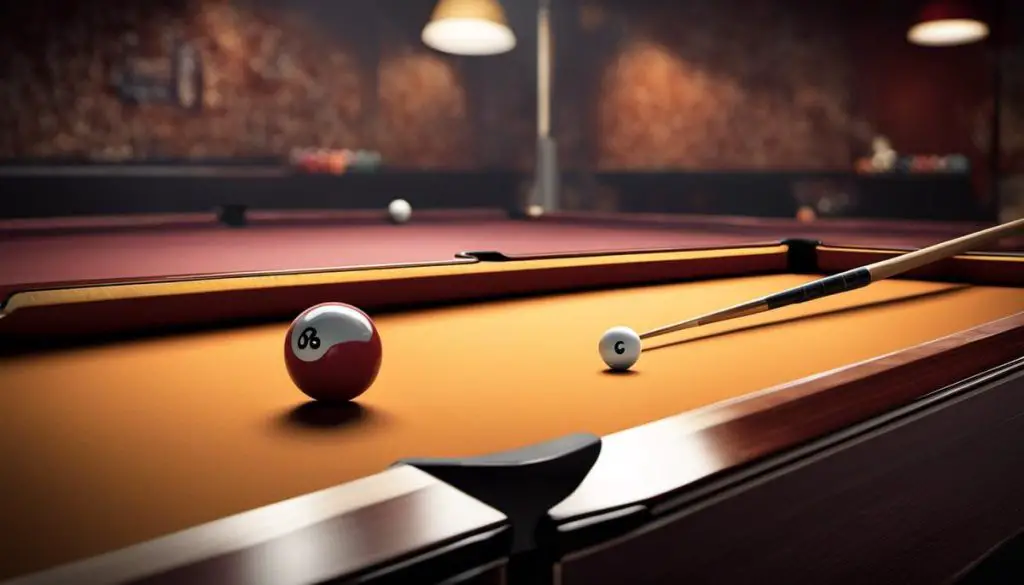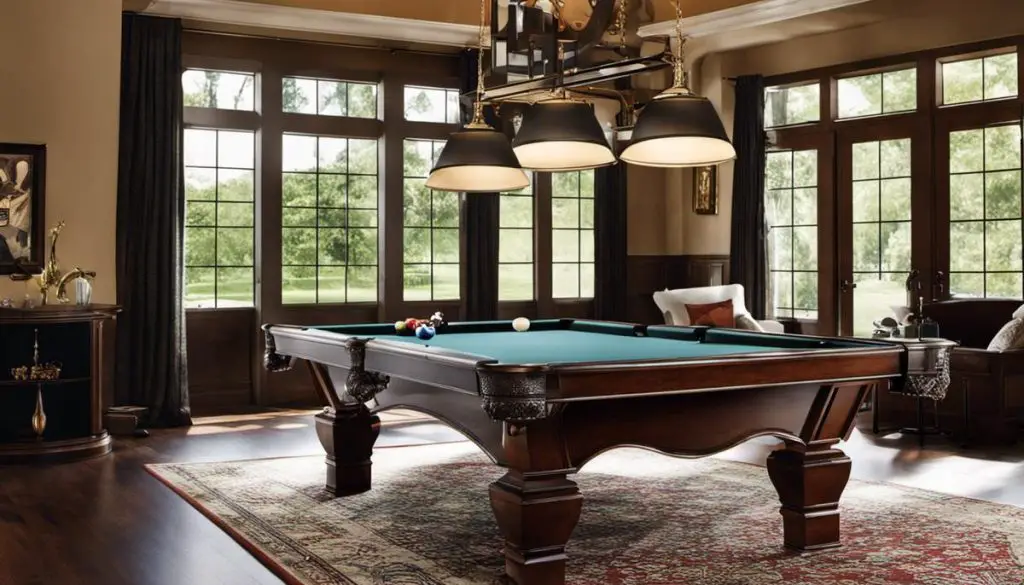Introduction to Snooker and Pool
Welcome to the fascinating world of Snooker and Pool! These two games, while similar in some ways, have unique characteristics that set them apart. Whether you’re a seasoned player or a beginner, understanding the basics and key differences between these two games can enhance your playing experience.
- Understanding the basics of Snooker and Pool
- Snooker vs Pool: Key differences
- Table Size: Snooker tables are larger, typically measuring 12 feet by 6 feet, while Pool tables are smaller, usually 9 feet by 4.5 feet or 8 feet by 4 feet.
- Number of Balls: Snooker uses 21 balls, while Pool uses 9 or 15 balls, depending on the game type.
- Scoring: In Snooker, points are scored for potting balls in the correct sequence, while in Pool, the player who pots all their balls and then the black ball, wins.
- Game Speed: Pool games are generally faster and more aggressive, while Snooker games tend to be slower and more strategic.
Snooker and Pool are both cue sports, played on a felt-covered table with pockets. The main objective in both games is to use a cue stick to hit a white ball (known as the cue ball), which then hits other balls and guides them into the pockets.
However, the rules, number and type of balls, and the size of the table vary between Snooker and Pool. For instance, Snooker is played on a larger table and uses 21 balls, including 15 red, 6 of other colors, and a white cue ball. On the other hand, Pool is played on a smaller table and uses only 9 or 15 balls, depending on the type of Pool game.
While both Snooker and Pool are cue sports, they have several key differences. Here are a few:
Whether you choose to play Snooker or Pool, both games require skill, strategy, and precision. They offer a great way to relax, have fun, and even improve your focus and hand-eye coordination. So, grab a cue and start playing!
History of Snooker and Pool
Understanding the history of snooker and pool can provide a deeper appreciation for these popular games. Let’s dive into their origins and how they have evolved over time.
- Origins of Pool and Snooker
The game of pool, also known as pocket billiards, has a rich history that dates back to the 15th century. It was initially played by the nobility in Northern Europe. The game was played on a lawn, similar to croquet, and it was later moved indoors onto a wooden table with green cloth to mimic the grass.
Snooker, on the other hand, was invented in the late 19th century by British Army officers stationed in India. The name ‘snooker’ comes from a military slang term for a first-year cadet or inexperienced soldier. It was a derogatory term used by Colonel Sir Neville Chamberlain to describe the players who failed to pot a ball.
For more detailed information, you can visit the Wikipedia page on cue sports.
- Evolution of Pool from Snooker
While pool and snooker originated from similar roots, they have evolved into distinct games over time. The biggest difference between the two is the number of balls used. Snooker uses 21 balls, including the cue ball, while pool typically uses 9 or 15, depending on the variant of the game.
Pool evolved from a game known as “pyramid pool”, which was a variation of snooker. The game of pool became popular in the United States in the 19th century, and it has since spread around the world. The rules of pool have also evolved over time, with different variants like eight-ball and nine-ball emerging.
Despite their differences, both games require a high level of skill and strategy, and they continue to be enjoyed by millions of people worldwide.
For more on the evolution of these games, check out the Wikipedia page on the history of billiards.
Influence of Snooker on Pool
The game of snooker has had a significant influence on the development and popularity of pool. This influence can be seen in the way pool has evolved over the years, as well as in the strategies and techniques used by players today.
- How Snooker shaped the development of Pool
- Snooker’s Impact on Pool: Case studies
Snooker, with its intricate rules and strategic gameplay, has greatly influenced the development of pool. The concept of potting balls in a specific order, which is a key element in snooker, was later incorporated into certain types of pool games. This added a new level of complexity and strategy to the game, making it more appealing to players who enjoy a challenge.
Additionally, the use of different colored balls in snooker inspired the design of pool balls. In traditional pool, the balls are numbered but not colored differently. However, in some variations of pool, like nine-ball and eight-ball, the balls are colored differently, similar to snooker.
Snooker’s influence on pool is not just limited to the game’s rules and equipment. The strategic thinking and precision required in snooker have also shaped the way pool is played. Many pool players have adopted snooker techniques to improve their game, such as the use of spin and the careful planning of shots.
There are many examples of snooker’s influence on pool, but perhaps the most notable is the rise of English pool. This variation of pool, which is popular in the UK and other parts of Europe, combines elements of both snooker and traditional pool. The game is played on a smaller table than snooker, but uses colored balls and requires players to pot balls in a specific order, similar to snooker.
Another case study is the game of nine-ball pool. This game, which is popular in the United States, also incorporates elements of snooker. The balls are colored and numbered, and players must pot them in numerical order. This adds a level of strategy and complexity to the game that is reminiscent of snooker.
These case studies illustrate how snooker has not only influenced the rules and equipment of pool, but also its popularity and development as a sport.
Billiards and Snooker
Billiards and Snooker are two popular cue sports that have captivated the hearts of millions worldwide. While they share some similarities, they also have distinct differences that set them apart. In this section, we will delve into the relationship between these two sports and examine how Snooker has influenced the popularity of Billiards.
- Understanding the relationship between Billiards and Snooker
- Impact of Snooker on the popularity of Billiards
Billiards and Snooker are both cue sports, meaning they are played with a cue stick and balls on a felt-covered table. They originated in the UK and have since spread to various parts of the world. Cue sports have a rich history, with Billiards being the older of the two games. Snooker, on the other hand, was developed later and is considered a more complex and strategic game.
Despite their differences, Billiards and Snooker share a common bond. The skills required in both games are similar, such as precision, strategy, and control. Many players often transition between the two games to enhance their skills and enjoy a different challenge.
Snooker’s popularity has had a significant impact on the world of Billiards. With its intricate rules and strategic gameplay, Snooker has attracted a younger, more diverse audience. This has indirectly boosted the popularity of Billiards, as many Snooker fans have developed an interest in other cue sports.
Moreover, the rise of televised Snooker tournaments has brought more attention to cue sports in general. This increased visibility has led to a resurgence in the popularity of Billiards, with more people taking up the game and more Billiards tournaments being organized worldwide.
In conclusion, while Billiards and Snooker are distinct games, they are intertwined in many ways. The popularity of Snooker has had a positive impact on Billiards, helping to introduce the game to a new generation of players and rekindle interest among existing fans.
Snooker and Pool Comparison
While both snooker and pool are cue sports, they are distinct in their rules and gameplay. Let’s delve deeper into these differences.
Rules and Gameplay
- Comparing the rules of Snooker and Pool
- Gameplay differences between Snooker and Pool
Snooker and pool have different rules that make each game unique. In snooker, the objective is to score more points than your opponent by potting balls in a specific order. There are 21 balls in total: 15 reds worth one point each, and six colors worth between two and seven points. The player must first pot a red, then a color, and so on until all the reds are potted. After that, the colors are potted in ascending order of their value.
On the other hand, pool has several variants like 8-ball and 9-ball, each with its own rules. In 8-ball, the game begins with a break shot, and players are assigned either solid or striped balls based on the first type of ball potted. The player who pots all their assigned balls and then the black 8-ball, wins. In 9-ball, players try to pot the balls in numerical order, with the game ending when the 9-ball is potted.
Snooker and pool also differ significantly in their gameplay. Snooker requires a higher degree of precision and strategy due to the smaller pockets and larger table size. The game is often slower and more tactical, with players spending more time planning their shots.
Pool, however, is generally faster-paced with more emphasis on potting balls quickly. The pockets are larger, and the table is smaller, making the game more accessible to beginners. However, mastering pool requires its own set of skills, such as controlling the cue ball’s position for the next shot.
In conclusion, while snooker and pool may seem similar at first glance, they are distinct games with their own unique rules and gameplay. Whether you prefer the strategic depth of snooker or the fast-paced action of pool, both games offer a fun and challenging experience.
Equipment and Table Differences
- How Snooker and Pool tables differ
- Comparison of Snooker and Pool equipment
Snooker and Pool tables may seem similar at first glance, but they have some key differences. A snooker table is larger, usually measuring 12 feet by 6 feet, while a pool table is smaller, typically 7 feet by 3.5 feet or 8 feet by 4 feet. The pockets of a snooker table are smaller and less forgiving than those of a pool table, making the game more challenging. The cloth covering a snooker table is also smoother and faster, allowing the balls to roll more freely.
The equipment used in Snooker and Pool also varies. Snooker balls are smaller, with a diameter of 52.5 mm, compared to pool balls which are 57.2 mm in diameter. Snooker uses 21 balls including the cue ball, while pool typically uses 9 or 15 balls depending on the variant of the game. The cues used in snooker are also longer and thinner, providing a different feel and requiring a different technique.
| Equipment | Snooker | Pool |
|---|---|---|
| Table Size | 12ft x 6ft | 7ft x 3.5ft or 8ft x 4ft |
| Pocket Size | Smaller | Larger |
| Ball Diameter | 52.5 mm | 57.2 mm |
| Number of Balls | 21 | 9 or 15 |
| Cue Length | Longer | Shorter |
Understanding these differences can help players appreciate the unique challenges and skills required in both Snooker and Pool. Whether you prefer the strategic complexity of Snooker or the fast-paced action of Pool, both games offer endless hours of fun and competition. For more information on Snooker and Pool, visit Wikipedia’s page on cue sports.
Conclusion: The Unexpected Influence of Snooker on Pool
As we reach the end of our exploration, it’s clear that the world of pool owes a great deal to its snooker counterpart. The influence of snooker on pool is not just historical, but also deeply ingrained in the rules, tactics, and even the equipment used in the game today. Let’s recap the key points and takeaways.
- Recap of Snooker’s influence on Pool
- Key takeaways from the evolution of Pool from Snooker
Snooker, with its complex rules and strategic play, has significantly shaped the way pool is played. The use of different colored balls in snooker, for example, has been adopted in some pool games, adding an extra layer of strategy. Snooker’s emphasis on precision and control has also influenced pool techniques, encouraging players to think several shots ahead. Furthermore, the design of snooker cues, with their smaller tips and lighter weights, has inspired changes in pool cue design, leading to the diverse range of cues we see today.
The evolution of pool from snooker is a testament to the dynamic nature of cue sports. It shows how games can adapt and change over time, borrowing elements from each other to enhance the player experience. The influence of snooker on pool has led to a more strategic and skillful game, enriching the sport and making it more enjoyable for both players and spectators. It’s a reminder that even as we enjoy the game of pool today, we’re part of a long and fascinating history.
In conclusion, the unexpected influence of snooker on pool is a fascinating aspect of cue sports history. It’s a testament to the rich and interconnected nature of these games, and a reminder of the strategic depth and skill they require. Whether you’re a casual player or a seasoned pro, understanding this influence can deepen your appreciation of the game and inspire you to develop your skills further.









